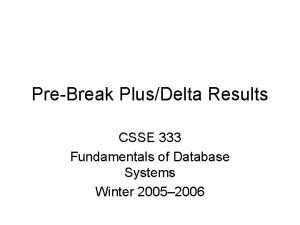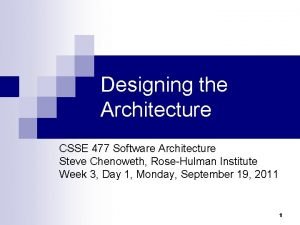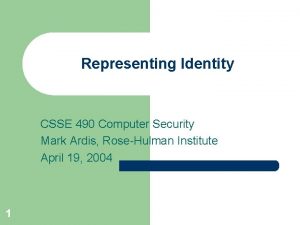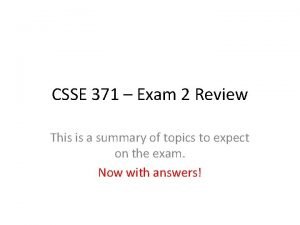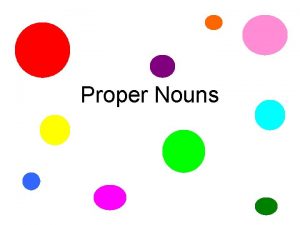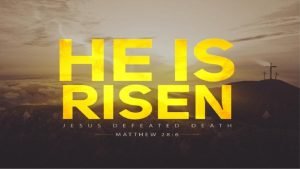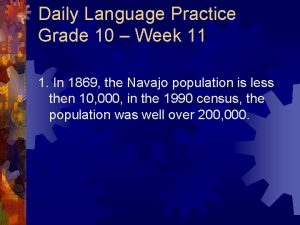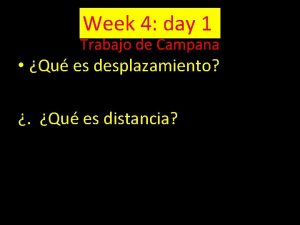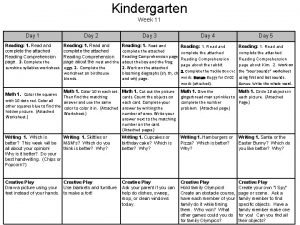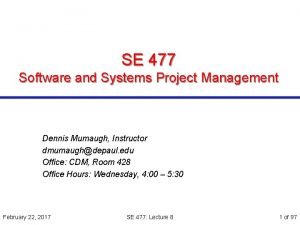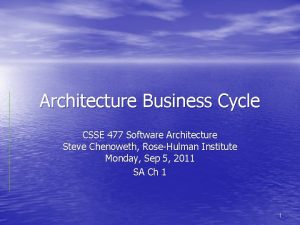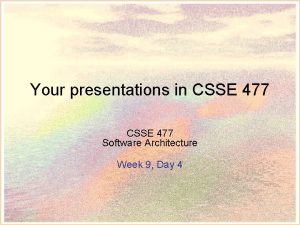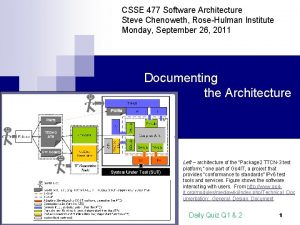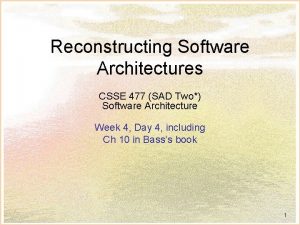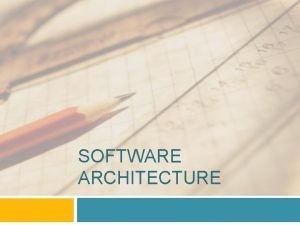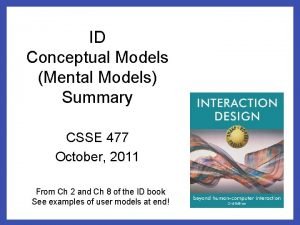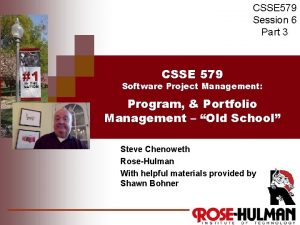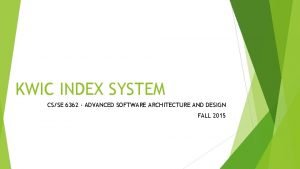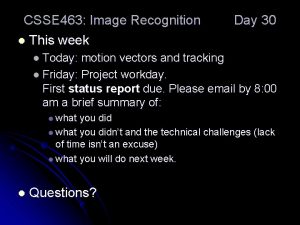Software Architecture CSSE 477 Week 5 Day 1



















- Slides: 19

Software Architecture CSSE 477: Week 5, Day 1 Statistical Modeling to Achieve Maintainability Steve Chenoweth Office Phone: (812) 877 -8974 Cell: (937) 657 -3885 Email: chenowet@rosehulman. edu Above – Modeling evolution requires setting up processes that can lead to taking meaningful measurements. 1

Maintainability? • Bass’s “Modifiability” attribute really links CSSE 477 back to 375, where we discussed in depth how to achieve this almost synonymous virtue. • As usual, Bass focuses on things about the design itself that can achieve this. • As was true with availability / reliability, we’re going to finish up by also discussing process. – What do you have to DO in terms of activities on a team, to make modifications easier / faster? 2

Statistical Modeling • Having meaningful numbers about the evolution and maintainability of a system • Leads into Measurable Maintainability (reference CSSE 375) • Starting point – can we measure the pieces of the horseshoe model? • Next step – can we explain / relate these results to the process used? • Then – can we change that process and investigate differences? The traditional horseshoe model – really for large-scale changes, but also applicable to regular maintenance. 3

What to model / measure? • Typically – bugs reported, time taken to fix a bug, etc. • Need to analyze these holistically, with people who know what’s going on. • Also need to know goals of each process. – E. g. , knowing time to fix different bugs leads to setting -up service contracts. • Need to take both kinds: – In-process metrics – End-goal metrics 4

Typical scenario – includes customer contact time! Time taken for each of these internal processes forms the in-process metrics: These should be controlled by an organisation to achieve the endgoal metrics. Corrective Maintenance Problem Reporting Problem Resolution Fix Distribution Difference between these two frames is an end-goal metric, which is customermandated and externally dictated 5

Terminology • Measurement = the raw data • Metrics & statistics = derived calculations • Modeling = underlying analysis of what influences what • Looking at these tends to cycle: – E. g. , Data on defects calculated “defect density” comparison with expectations or history looking at more specific data to find causes 6

Based on a quality management model … • Every development team needs metrics goals: – Short term – Long term • And a roadmap for how to get there. – Can’t just be “try harder. ” • Falls in line with the Deming plan: – Plan Do Check Act 7

Deming applied to swre evolution - 1 Plan = • Anticipate workload • Stipulate end goals, service contracts • Staff appropriately • Design the processes for problem resolution 8

Deming applied to swre evolution - 2 Do = • Provide training • Carry-out reporting, resolution and fix distribution activities • Collect appropriate metrics 9

Deming applied to swre evolution - 3 Check = • Periodically check end-goal and in-process metrics – If you have a project manager whose main job this is, “periodically” can mean “daily” 10

Deming applied to swre evolution - 4 Act = • Modify processes • Replan • Keys – like managing other processes: – What is your goal and where do you want to go? – What is your current position – Knowing where you are and where you want to go, what steps should you take? 11

Typical metrics strategy • Decide what you want to measure and how to measure it. – See next slide • Set targets and track them. – Likely includes both qualitative and quantitative – Targets should be “SMART” • Understand variability, work towards minimising variability. – Consistency = predictability – Well-known stats should have upper and lower bounds – Variabilities need to be studied for root causes • Act on data and strive for continuous improvement. • Consider the human angle. – Hard to measure people’s “progress” like a machine’s. 12

What to measure • Is this measurement relevant to the project? – E. g. , Maybe portability isn’t relevant to the first release… • Is it easy to measure? – Ideal is “no extra effort” to measure. – E. g. , can it come automatically from the repository? • • Is it one of the most valuable things to measure? Can we quantify the costs / benefits of measuring it? Is it controllable? Can you afford NOT to measure it? 13

Common measurements - 1 • Mean time between failures = average time between arrival of bugs. – Can be calculated from defect repository. • Mean time to repair = Avg time to fix a bug; indicates responsiveness to bugs and effectiveness in fixing problems that are not reported. – Can be calculated from defect repository. 14

Common measurements - 2 • Number of problems responded to by “first level support” = The effectiveness of that level, implies number of interruptions to development team. – Can be calculated from Customer Support Repository • Classification of defects by severity = The nature of incoming problems. Measures the demand on support and maintenance resources. – Can be calculated from Defect Repository. 15

Common measurements - 3 • Classification of defects by product component = Problem-prone parts of a product, and hence points to areas of the product that need to be looked into more carefully. – Can be calculated from the Defect Repository 16

Best practices in metrics • Automate the process via repositories. • Integrate metrics into operational decision-making, not just as a collection mechanism. • Overdosing on metrics – not good! • Decide what to measure first. • Use for performance appraisal. – Oh, wait – Don’t do that. • Make it a closed loop. Data fire hose in action 17

Article on Measuring Evolution • Tom Arbuckle, “Measuring Software – and its Evolution – Using Information Content, ” 2009. • Idea – to examine evolution, need to measure related artifacts over time. • Thesis – relative Kolmogorov complexity is the correct fundamental measurement. – “Algorithmic entropy” – Measures number of bits of information in an object. Above - And here he is, the father of information theory – Claude Shannon. 18

Article, cntd • “Information size is highly correlated with counting size”. • Given that many SE metrics count features representative of software artifacts - lines, methods, calls - we claim that this result provides some evidence both for our argument but also for those who may claim that existing metrics are good enough. • In the rest of the paper, they try to find good ways to measure the Kolmogorov complexity in software programs! (E. g. , section 3. 1. ) 19
 Day 1 day 2 day 3 day 4
Day 1 day 2 day 3 day 4 Csse results
Csse results Csse quiz server
Csse quiz server Representing identity in information security
Representing identity in information security Csse exam
Csse exam Day 1 day 2 day 817
Day 1 day 2 day 817 Week by week plans for documenting children's development
Week by week plans for documenting children's development What is architecture business cycle?
What is architecture business cycle? Call and return architecture in software engineering
Call and return architecture in software engineering 8 day week
8 day week Proper noun names
Proper noun names 5-a-day language review week 26 answer key
5-a-day language review week 26 answer key Pros cons presentation
Pros cons presentation Monday is my favorite day of the week
Monday is my favorite day of the week Now upon the first day of the week
Now upon the first day of the week Daily language review week 11 answer key
Daily language review week 11 answer key Week 4 day 1
Week 4 day 1 Week 11 day 3
Week 11 day 3 Holy week day 1
Holy week day 1 Sw 477
Sw 477

